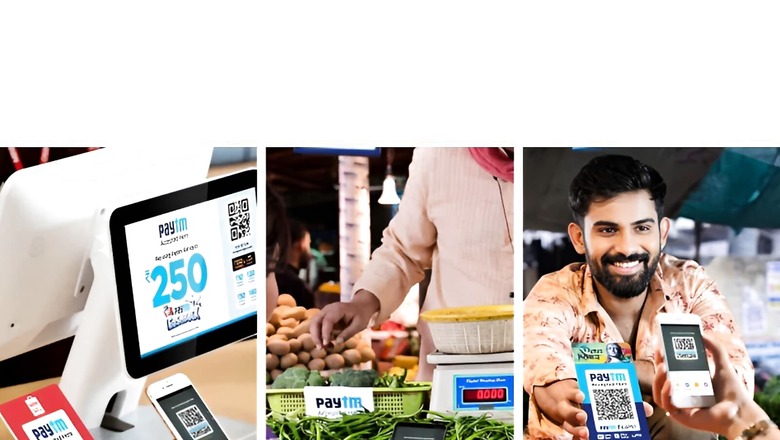
views
As the pioneer of mobile payments and QR technology, Paytm has established itself as a leader in India’s rapidly-expanding digital payments space and has become the go-to payment platform for millions of Indians.
As India’s largest payments platform, Paytm is the leading digital ecosystem for consumers and merchants.
We help merchants grow their businesses by giving them solutions that allow them to accept payments, acquire and retain consumers, improve their business operations and access financial services.
Paytm was the first company to launch QR payments for in-store merchants in India in 2015, allowing small shopkeepers to accept digital payments at zero upfront cost. We launched the All-in-One QR Code in January 2020, giving merchants the power to seamlessly accept payments from multiple instruments like Paytm Wallet, Paytm UPI, Net Banking, Paytm Postpaid, all major debit cards, credit cards and prepaid cards, and all other UPI apps directly into their bank account.
For online merchants, Paytm offers a comprehensive platform to accept payments through Paytm Payment Gateway. By integrating the service, merchants can start accepting online payments and expanding the digital reach of their businesses.
As the company looks to grow profitably by leveraging its technological capabilities and customer base, Paytm has been able to deliver strong growth in the recent quarter through two key margin drivers in its payment business – payment processing and subscription revenues.
For payment services, Paytm primarily generates revenues from the transaction fee it charges merchants based on a percentage of transaction value and consumer convenience fees from consumers for certain types of transactions. The fee percentage varies by the type of payment instrument used by consumers and the category of merchant.
Paytm also earns recurring subscription fees from merchants for certain products and services, such as Paytm Soundbox and PoS.
We have demonstrated our leadership in offline payments with 5.8 million merchants paying subscriptions for our payment devices, such as Soundbox and PoS, as of December 2022. Our subscription-as-a-service model drives strong adoption of devices, which leads to higher payment volumes and subscription revenues. This in turn increases the funnel for our merchant loan distribution.
The company’s revenue from Payment Services to Consumers, which includes income from use cases such as bill payments and top-ups on the Paytm app, grew by 55% from a year ago to ₹549 crore in Q2FY23. Consumers pay platform fees to Paytm for select use cases whereas merchants pay MDR or Merchant Discount Rate.
Meanwhile, revenue from Payment Services to Merchants rose 56% year-on-year to ₹624 crore in the Q2FY23, driven by strong growth in the payments devices business.
Payment Services to Merchants includes revenues from Paytm’s comprehensive offerings of online and in-store payment acceptance services such as Payment Gateway, All-in-one and Dynamic-QR, POS, and Soundbox. Merchants pay MDR for cards, wallet, net banking payments, and subscriptions for devices.
For UPI person-to-merchant payments, the government pays incentives.
In the latest analyst presentation, Paytm said that it charges around ₹100 per month per active device with some high-end devices commanding higher fees of up to ₹250 per month. In some cases, select installations also receive additional incentives from partner banks, the Reserve Bank of India (RBI), and the National Bank for Agriculture and Rural Development (NABARD).
Paytm’s management believes that it is still the early days of payments in India as there are only 25 crore registered UPI users and 1 crore total devices in the market. Paytm believes that India could have the potential of 10 crore merchant entities and more than 50 crore payment customers in the near term.
“We believe overall subscriptions for payment and other services will be a large market,” the company said in a presentation to analysts recently.
Through payment processing, Paytm makes a net payment margin of 7-9 bps of GMV. Of this, 3-4bps are earned from UPI transactions and 15-18bps from transactions through other instruments such as wallet, debit card and credit card.
Paytm believes that government incentives for UPI could be higher this year due to a rise in volumes.
“Due to the tailwinds for UPI merchant payments, we are also able to make attractive subscription revenues for payment devices, and MDR for non-UPI payments,” Paytm said in its Q2 earnings release.
Given UPI is growing at a faster pace than other instruments, Paytm expects its blended margin to stabilize at 5-7 bps. The company also noted that payment processing charges will trend lower as a percentage of GMV due to the increasing mix of UPI as well as routing and rate optimizations.
Payment processing charges as a percentage of GMV came down to 0.23% in Q2 FY23 compared to 0.34% in the corresponding quarter last year.
Paytm’s net payments margin stood at ₹443 crore, up 428% year-on-year, driven by improved monetization and continued improvements in payment processing charges.
We see merchant subscriptions as an attractive profit pool driving higher payment volumes, subscription revenues as well as merchant loan distribution.
Further, higher GMV from online merchants in the payment gateway business and continued growth in subscription and MDR revenues from our offline merchants helped Paytm clock a 56% growth in Q2FY23 Payments Services revenue.
Paytm is also expanding its monetization base with the growth of users and merchants.
UPI is helping Paytm with efficient user and merchant acquisition. Since the offering is free for merchants, it hence encourages high usage.
In addition to government incentives, the opportunity to upsell loans as well as payments devices to merchants has made UPI economically viable for Paytm.
Payments offerings such as Paytm QR are the company’s primary means to onboard offline merchants, whereas products such as Soundbox and PoS devices increase merchant engagement and retention in Paytm’s ecosystem with attractive monetization characteristics.
In 2019, we became the first in the market to introduce an IoT-enabled payment acceptance device, Paytm Soundbox, that helps merchants get instant audio confirmation on every payment received via QR code. With Soundbox, Paytm brought about a technological innovation in in-store payment acceptance in India.
In 2021, the capabilities of the Paytm Soundbox were upgraded with the launch of Paytm Soundbox 2.0 equipped with Paytm All-in-One QR Code and a digital screen that gives instant visual confirmation of the paid amount along with voice notification.
The innovative device has addressed a gap and specific need among merchants and has played a pivotal role in establishing digital transactions as a safe and secure process, enhancing the trust of merchants and consumers to move digitally.
Given our wide suite of offerings to merchants, and the ability to drive higher consumer engagement and stickiness through Paytm Payment Instruments, Paytm has a unique monetization model compared to its peers.
Brand Connect.
Read all the Latest News here




















Comments
0 comment